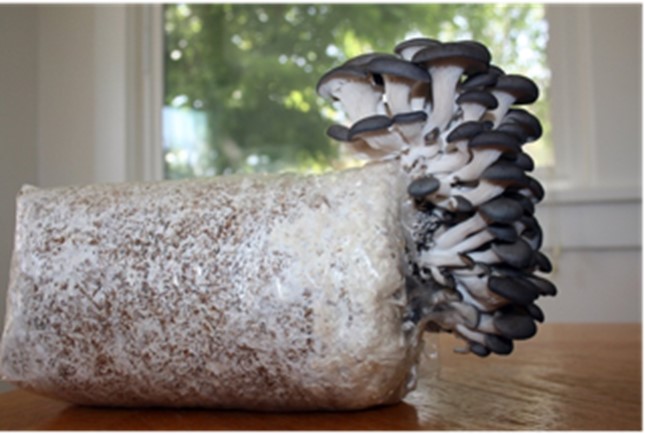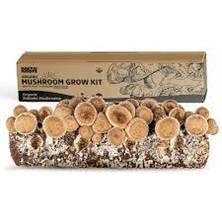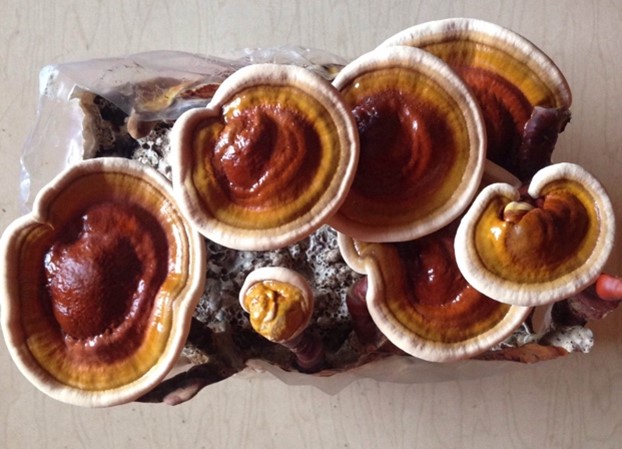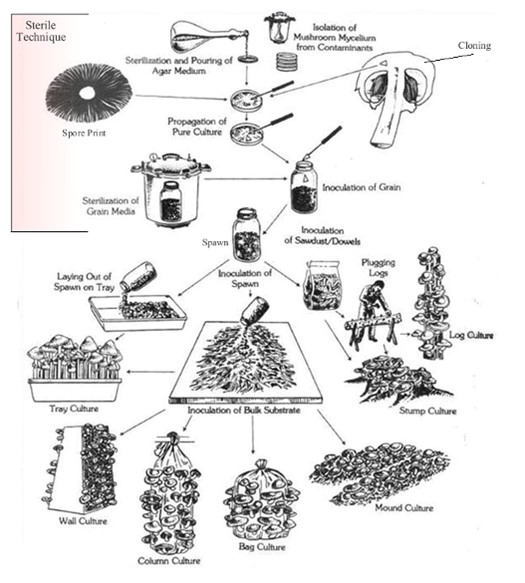Fungi support our global food system, enhance soil health, encourage nutrient flow between plants and within the soil, and help breakdown organic matter. Mushrooms, the nutrient dense fruiting bodies fungi produce, offer a wide variety of health benefits for humans since they contain a variety of vitamins, minerals, amino acids, and fatty acids. They are high in protein and fiber and are low in cholesterol and fat. Some of the most popular culinary mushrooms, lion’s mane, reishi, shitake, and oyster, have been observed improving brain and liver function, as well as supporting our immune, cardiovascular, and respiratory systems. The best news is that all these mushrooms can be grown in your home!
Growing your own mushrooms is easy, uses little water and can produce high yields. As stated in, “Mushrooms: A Resilient Crop” on ABQ Stew, mushrooms are a sustainable small-scale crop with a low startup cost. They only take up as much space as you want and are a fabulous meat substitute. Most have a firm texture allowing them to be cooked down and flavored in many ways making them indispensable while cooking. Once you are done growing your mushrooms, the substrate can be composted in your garden to enhance your soil composition. Monitor where you put it in as you might end up with another harvest!




To grow you own mushrooms, you can either buy a grow kit or start from scratch. Grow kits are less intensive to start up, however, a DIY kit can enable you to learn more about the process. For the best results, follow any instructions provided with your kit. They usually cost between $20-$50 after shipping and come in a block referred to as “mushroom spawn”. This mycelium network has already been developed and allows you to grow mushrooms faster. Grow kits tend to be the most accessible and will boast high yields for beginners. I purchased a grow kit from Sun Dream farm in PA and documented the process.
To begin growing from scratch, try to source your materials as locally as possible. Liquid spore cultures will be the hardest to find, however, they are sold by many vendors on the internet and start around $15 for 10ccs of liquid . The type of mushroom you want to grow will determine what substrate you need. Lions’ mane, reishi, and shiitake mushrooms grow well in sawdust which can be made at home, purchased online or found down the road. They can also be grown in straw which can be purchased by the bale. Oyster mushrooms can be grown in coffee grounds which are free from coffee shops. Lions’ mane, shiitake, and oyster mushrooms can also be grown in logs such as oak, maple, and aspen. Grow Bags and trays online start cheap and can be purchased in bulk. Check in with your local garden center to get used seedling trays for free. Humidifiers start at around $15; spray bottles are as little as $1, and thermometers start around $5. Humidifiers are best for larger tray grows where most of the substrate will be exposed while fruiting.
Now it is time to inoculate your substrate. It is best to do this under relatively sterile conditions to reduce undesirable bacteria. Sawdust and straw can be soaked in hot water to be pasteurized. Pack your substrate into your container and keep moist. Introduce the spores into the substrate via sterile syringe. Seal the container permitting a small amount of air flow. For logs, drill holes 2-3 inches deep, pack the spore substrate mixture into the holes and seal with bee’s wax. Keep them in a dark, temperature-controlled environment (55-75 degrees) to allow the mycelium to develop. Keeping the spores warm after inoculation help them grow faster, therefore, a heating pad on top of the substrate can help maintain a consistent temperature if needed. In dryer climates, it may also be beneficial to also run a humidifier depending on the grow scale. As for logs, put them outside in a shady area that stays moist. Ideally, they should all be in contact with the ground. You will know the mycelium network has developed once you see a fine fuzzy coating appear on the outside of the substrate.
To encourage fruiting, remove any heaters but keep humidifiers running. Once you open your container, you don’t want the substrate to dry out. Cut either an x or a line in a bag and remove the lid from the tray. Fold and tape down excess bag to protect the substrate. Spray the exposed area with water to keep moist, avoid making the substrate soggy. Expose the container to natural but not direct sunlight to help the mushrooms grow, imagine how much light they would get on a forest floor. Log inoculations operate more on their own time since the mycelium must work its way through the wood itself before fruiting.
Your first harvest will be 3-4 weeks after the mycelium develops. Fresh mushrooms go fast so harvest and eat them regularly. Fresh mushrooms store well in a paper bag for about a week. To harvest, grab around the whole mushroom and twist off at the base, try not to disturb the substrate. You will most likely be able to get multiple harvests. Now it is time to enjoy the fruits of your labor and add them to your diet!
My experience growing Lions mane mushrooms with a kit from Sun Dreams Farms was incredibly easy, satisfying, and delicious. The block arrived with a well-developed mycelium network, so I was able to harvest my first mushroom within 11 days of receiving the kit! See below for some photos documenting the experience.

-Posted by Wil


